How Deforestation Affects Animals In The Amazon
Deforestation in the Amazon Rainforest
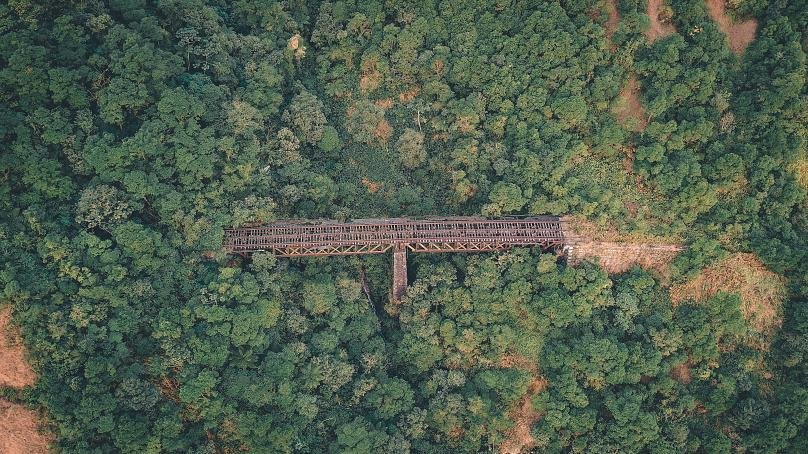
Photograph by Sergio Sousa

By Brandon Wegrowski
Published Fall 2019
Preferred Citation: Wegrowski, Brandon. "Deforestation in the Amazon Rainforest." Ballard Cursory. December 2019. world wide web.ballardbrief.org.
+ Summary
Deforestation in the Amazon rainforest represents a critical issue in our modern world, equally it is the root crusade of many other bug that bear on the unabridged planet. The Amazon'south deforestation is peculiarly relevant because information technology has been a chronic issue that has plagued the region for decades. Some of the key contributing factors include cattle ranching, infrastructure development such as roads, the building of many large dams, and small subsistence farming. Consequences of deforestation in the Amazon include a significant loss of species and their habitats, a disturbance of indigenous peoples and their health, an increase in CO2 emissions, and a negatively altered water cycle effectually the world. Many practices have been used to combat the issue, including increased monitoring of deforestation levels, expanding land rights and protection to indigenous peoples, land policy reform, and anti-deforestation legislation, but each have their own different strengths and weaknesses.
+ Key Takeaways
+ Key Terms
Amazon - A large tropical rainforest occupying the drainage basin of the Amazon River and its tributaries in northern S America, and covering an area of two.3 million square miles (6 million square km). Comprising virtually 40% of Brazil's full area, information technology is bounded past the Guiana Highlands to the north, the Andes Mountains to the west, the Brazilian central plateau to the south, and the Atlantic Ocean to the east. 1
Amazonia - The area around the River Amazon in South America, principally in Brazil, but besides extending into Peru, Colombia, and Bolivia. The region comprises approximately ane tertiary of the world'due south remaining tropical rainforest. ii
Amazonia Legal (Legal Amazon) - An area of five.2 million km, constituting all of the Brazilian Amazon. The Brazilian government created the Amazonia Legal designation in 1953 as a manner to program and promote the social and economical development of states in the Amazon region, which historically share the aforementioned economic, political, and social challenges. 3
Deforestation - The action or process of clearing forests. four The United nations 2020 Global Woods Resources Cess defines deforestation equally "the conversion of woods to other state use independently whether human-induced or not." five
Desertification - The process by which fertile state becomes desert, typically equally a issue of drought, deforestation, or inappropriate agronomics.
Evapotranspiration - The process by which h2o is transferred from the land to the atmosphere by evaporation from the soil and other surfaces and by transpiration from plants.
Forest - Areas having more than fifty% tree cover.6
Hectare - i hectare is nearly two.47 acres.
Land Surface Albedo - The ratio of the solar radiation reflected from Earth's surface to the solar radiation incident upon information technology, which is critical to the regulation of Earth's surface free energy budget. In essence, land surface albedo is a measurement of the "whiteness" or reflectivity of the surface of the land.
Logging - The clearing (land) of trees to produce lumber.7
Mato Grosso - A large land in west-central Brazil well-nigh covered in Amazon rainforest.
Reforestation - The act of renewing wood encompass (as by natural seeding or artificial planting of seeds or young trees).eight
Slash-and-burn - Relating to or denoting a method of agriculture in which existing vegetation is cut down and burned off before new seeds are sown, typically used as a method for clearing forest land for farming,9 also called fire-fallow tillage.
Uncontacted Tribes- Tribes who have had no peaceful contact with anyone in the mainstream or ascendant society.
Context
Forests represent a critical part of our planet'southward environmental health, and they affect the environment on many levels.ten Sustainably managed forests provide numerous goods and services11—the World Wild animals Fund estimates that 1.six billion people worldwide depend on forests for their livelihood, 300 one thousand thousand of whom live in forests.12 Forest ecosystems are too dwelling to lxxx% of the world's terrestrial biodiversity, including countless species of plants and animals, many all the same yet to exist discovered.13 Subsequently, deforestation affects the environment, the economy, and even homo health.14 The Earth's climate is especially affected, as deforestation emits CO2 into the atmosphere. Simply deforestation likewise has biophysical effects, including changes in land surface albedo, evapotranspiration, and deject cover.15
The Amazon is the largest rainforest in the world as well as the largest river basin, spanning 670 one thousand thousand hectares16 across ix South American countries: Bolivia, Brazil, Colombia, Ecuador, French Guiana, Guyana, Peru, Suriname, and Venezuela.17 The Amazon contains more than species of plants and animals than anywhere else on the planet, and is believed to be the home of ten% of all species on Globe.18 Of the many constitute species in the Amazon, 75% are unique to the Amazon. There are 3,000 different species of fish, which is the largest number of freshwater fish species in the globe.19 Additionally, the Amazon rainforest is dwelling to 34 1000000 people who depend on its resource.20
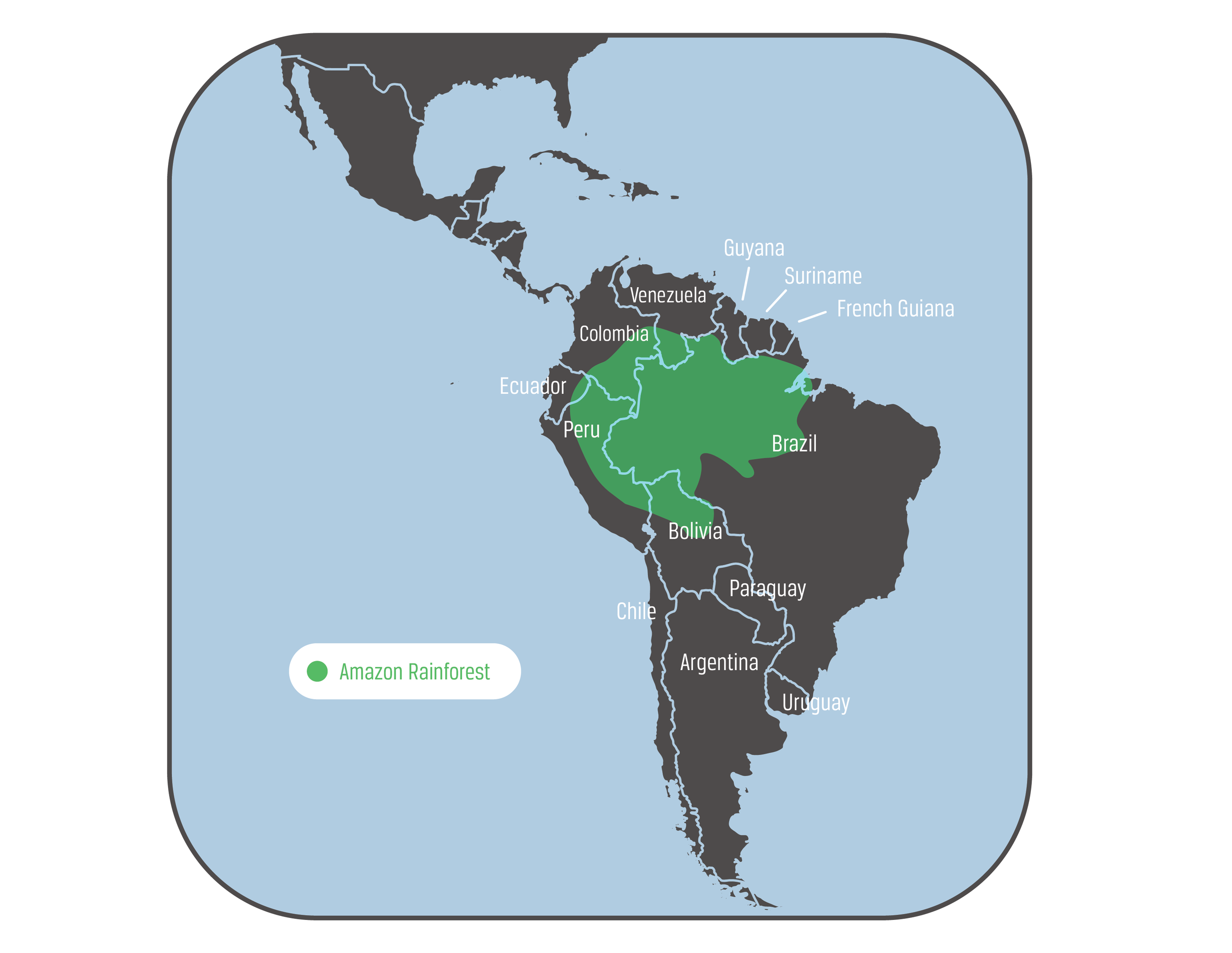
The Amazon spans more than 670 million hectares, making it the largest rainforest in the world.

twenty% of the Amazon biome has been lost already, and it is estimated that 27% will be without trees past 2030 if the electric current rate of deforestation continues.
The Amazon rainforest is as well the planet'south largest deforestation front.21 With 90-140 billion metric tons of carbon stored in the Amazon'southward forests, deforestation breeds high potential for "large-scale, irreversible ecological disaster."22 Already, 20% of the Amazon biome has been lost, and the Globe Wildlife Fund estimates that 27% of the Amazon biome will be without copse by 2030 if the electric current rate of deforestation continues.23 From 1978 to 2017, over 750,000 foursquare kilometers (75,000,000 hectares) of the Amazon was destroyed.24 Between 2001 and 2012, forest losses in the Amazon biome averaged virtually 1.4 meg hectares per year, totaling 17.vii million hectares, by and large in Brazil, Peru, and Bolivia. The country of Brazil is a key player in deforestation, and was responsible for 75% of the deforestation in the Amazon from 2001-2012.25
Contributing Factors
Authorities Involvement
I gene that influences Amazonian deforestation, as well as its other contributing factors, is government involvement. This takes the class of legislation, or lack thereof, that directly protects the forest, simply also includes the policies surrounding logging permits, the process of designating protected lands, and the rules around businesses involved in the Amazon rainforest. These policies include penalties, fines, warnings, and seizures of equipment, or lack thereof, when legislation is violated. As the Amazon rainforest includes territory of nine different countries, multiple governments are involved in its protection. However, the virtually influential government by far is the Brazilian government equally 64% of the Amazon falls within its borders.26 27
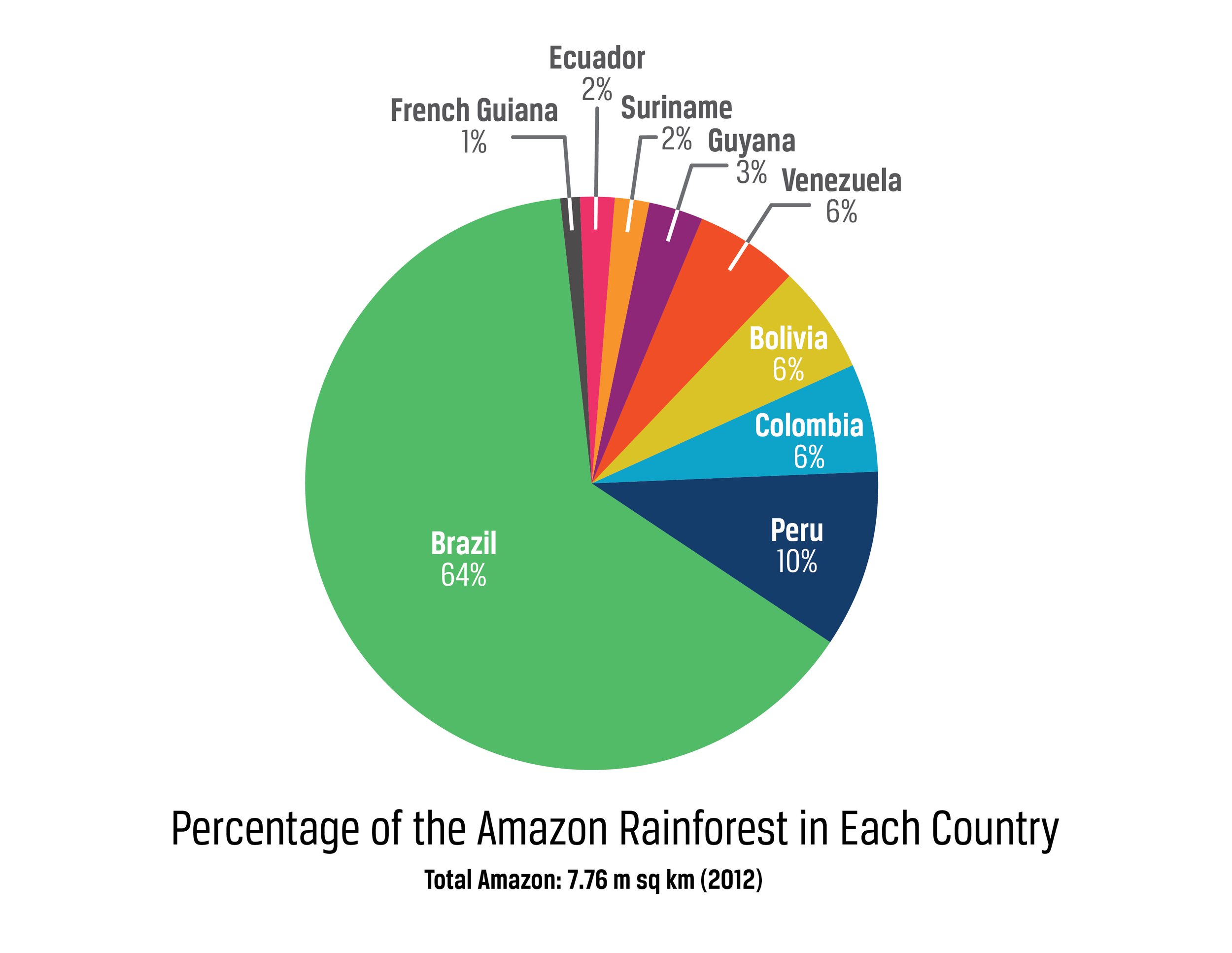
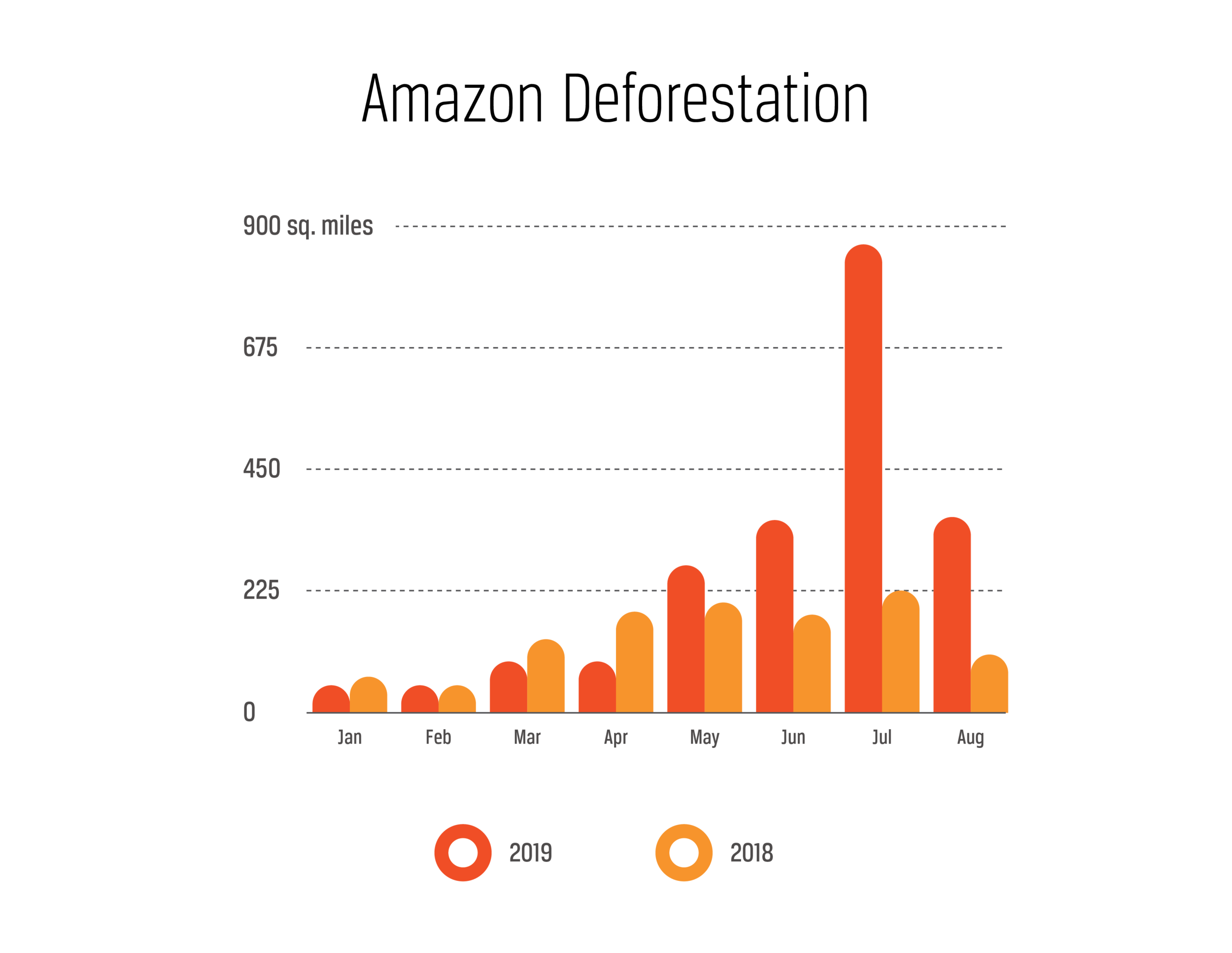
Summer 2019 saw high rates of deforestation in the Amazon compared to previous years.
From 2004 to 2012, the Brazilian government put several legislative measures in identify to protect the Amazon and, every bit a consequence, deforestation in the Brazilian part of the Amazon dropped to its lowest recorded levels.28 29 However, governmental power and its furnishings can quickly alter and, since the most recent President of Brazil began his term on January 1, 2019, a few cardinal statistics accept noticeably decreased. Enforcement actions past the main environmental bureau of Brazil dropped by 20% during the offset six months of 2019, compared with the beginning half dozen months in 2018.thirty There was so a 39% increment in forest cover loss when comparison the similar January–July catamenia between 2018 and 2019.31 Furthermore, in June 2019 alone, the rate of deforestation in Brazil rose 88% compared to June of the previous year.32 These data signal that regime involvement in policy creation and enforcement is an influential factor, and, later, can play a role in many of the following contributing factors.
Cattle Ranching
Cattle ranching is the biggest single crusade of deforestation in the Amazon rainforest, accounting for almost 80% of the Amazon's deforestation as forests are cleared for farmers to enhance herds of cattle, primarily for exporting beef.33 The Brazilian Amazon is home to most 200 million head of cattle and is the largest exporter of cattle products in the world, supplying a quarter of the cattle products in the global market.34
Deforestation acquired by cattle ranching is supported by an international need for cattle-related products, including leather, meat, dairy, and cosmetics, which flow into companies in multiple industries worth billions of dollars.35 Deforestation through cattle-ranching is further driven by low costs for inputs, such as breeding bulls or cows, fencing, artificial feed, medicine, and labor, besides as ease of transportation and inexpensive land.36 At the onset of these deforestation problems, the government of Brazil had incentives for many years to increase land usage and ownership through cattle and clearing state.37
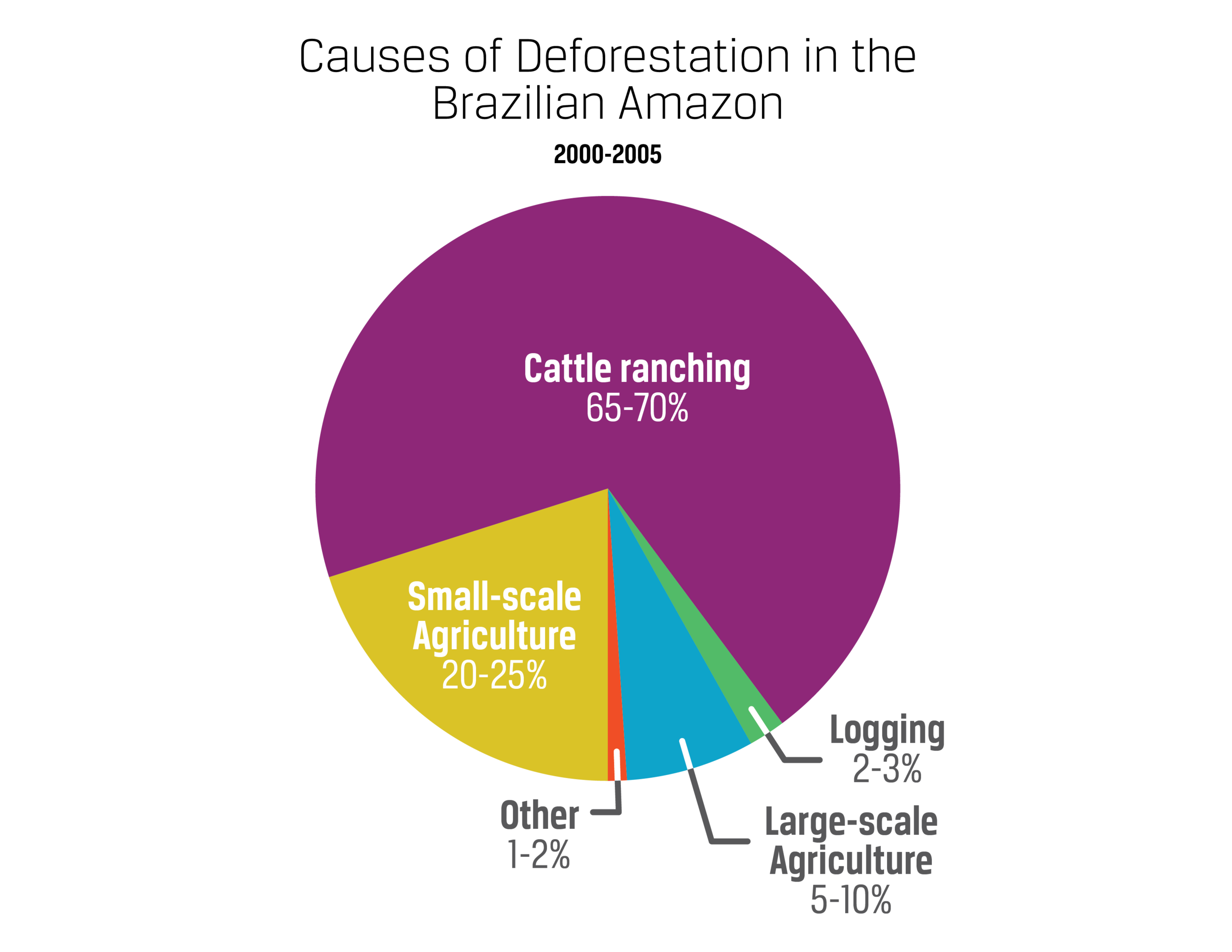
Infrastructure Development (Roads)
Roads and other related infrastructure take a huge impact on deforestation by increasing accessibility to the forest. Later on extensive inquiry into all roads and transportation routes (including those that were illegal or unofficial), ane study found that near 95% of all deforestation occurred within either five.5 km of roads or i km of rivers, as both facilitate much more access to the rainforest.38 Additionally, the study found that protected areas near roads and rivers had much lower deforestation (ten.nine%) than did unprotected areas virtually roads and rivers (43.6%).39
Although there are many illegal and unofficial roads contributing to the issue, the Trans-Amazonian Highway is a big piece of this problem. This highway stretches 4,000 kilometers across Brazil (and the very middle of the Amazon) and connects the coastal city of João Pessoa to the northeast border of Peru.xl The highway'southward first portion opened in 1972, but it has withal to be completed as construction has been interrupted due to a lack of financing and other bug.41 This road allows deeper admission into the Amazon and, following its structure, deforestation levels spiked.42 It is estimated that, at its worst in the 1990s and early 2000s, more than 25,000 foursquare kilometers of wood were cleared per year every bit a outcome of the highway.43
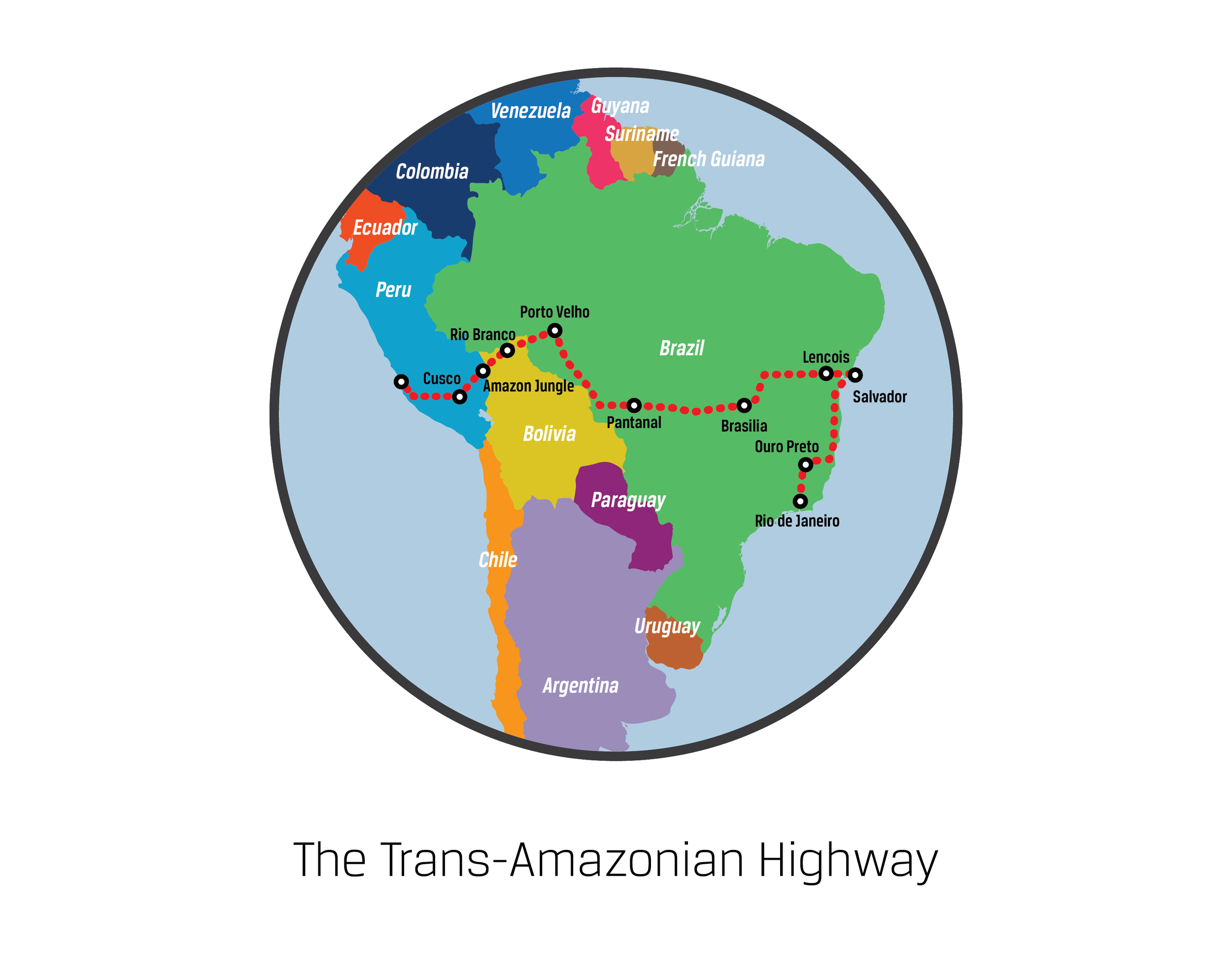
Hydropower dams
There are well-nigh 150 dams in the Amazon region, with hundreds more than planned.44 Dams contribute to deforestation by replacing large swaths of forest with reservoirs of water. One example is the Belo Monte Dam, which is the fourth largest hydroelectric project on Globe. Its reservoir was filled in 2015, taking out 260 square miles of lowland and forest.45 Other examples of dams in the Amazon include the Balbina, Tucuruí, and Samuel dams. The area of wood lost to reservoir cosmos was ane,200 square miles at Balbina, 744 square miles at Tucuruí, and 168 square miles at Samuel.46 Perhaps most notable, however, is the Tucuruí Dam, which is located in the northeastern Brazilian Amazon and is the largest dam ever built in a tropical rainforest.47 Its reservoir displaced 40,000 people and flooded 2,875 square kilometers of wood.48
Flooding forests for reservoirs is non the only manner dams contribute to deforestation. In addition, dams displace populations (Belo Monte has displaced 20,000 indigenous people since it was built in 2015),49 attract more people to the dam location with related jobs, and expose areas along the many roads that are built to each dam. All of these effects lead to more deforestation via increased country development and increased access for various groups engaged in deforestation.l Many projects associated with these dams, like that of creating waterways for soy transportation, contribute to deforestation every bit well.51
Minor Subsistence Agronomics
Around the world, agriculture accounts for well-nigh 27% of all forest loss, and Amazonia is no exception.52 Oft, farmers will use slash-and-burn down techniques to clear land for growing or harvesting commodities like soy, palm oil, gilded, sugarcane, and beef, which depletes the forest cover and increases the chance of fire. In 2003, ane of the worst years for deforestation in the Amazon, information technology was discovered that more twenty% of the forest in Mato Grosso (a Brazilian state) was converted to cropland.53 Much of this specific cause is powered by global markets and economic atmospheric condition.54 Generally, specific deforestation rates tend to ascent and autumn in concert with the cost of soybeans, beef, timber, and other crops in the region.55
Consequences
Loss of Habitat or Species
Human being disturbance and deforestation of the Amazon rainforest results in degradation of species. Decades of research shows that principal forests such every bit the Amazon are crucial in maintaining biodiversity; subsequently, forested areas with increased human interference (such every bit deforestation) experience reductions in species multifariousness.56 Data from a 2015 report on the Amazon show that loss of biodiversity is occurring in the rainforest's ecosystem,57 and a subtract of species richness was found to be higher in areas where deforestation has occurred to make room for agronomics.58
The elimination of tree encompass is the main reason for species disturbance. Non simply exercise the trees of the Amazon rainforest provide a dwelling house for many species, just the awning of the rainforest also regulates temperature which is critical for numerous other species. Without the regulation these tree canopies provide, the environs becomes more like a savannah with much less vegetation, a highly variant temperature from day to night, and much lower humidity levels. This change also results in high winds and exposure to straight sunlight, solar radiations, and, at times, heavy precipitation, all of which could show fatal to many species.
In that location are many implications as to why experts are concerned over the loss of species diverseness in the Amazon; approximately 80% of the world'due south terrestrial biodiversity lives in wood area, and there are thousands of species of plants and animals unique to the Amazon rainforest that are found nowhere else in the world, such as pink river dolphins, macaws, toucans, tamarins, and glass frogs. Many species of plants and animals indigenous to the Amazon accept made and go along to make unique contributions to scientific discipline and medicine, and data suggests that a constancy in deforestation may lead to the extinction of certain plants and animals such as these.59 This trend can already exist seen with the endangerment of many species including the Amazon Fer-de-lance viper and the three-toed sloth.threescore Data suggests that species variety volition continue to decline if deforestation trends continue.61
Disturbing Indigenous Peoples
Thirty-three meg people inhabit the Amazon rainforest, and there are over 350 indigenous communities that depend on the forest and its resource for survival.62 However, those numbers used to be larger, and many tribes and communities have get extinct due to deforestation and its accompanying side furnishings, including loss of food sources, soil erosion, water contamination, and exposure to foreign diseases to which aboriginal people do not accept natural immunity. These diseases are brought in by illegal loggers, farmers, and ranchers.63
Although many of these Amazonian peoples have legal protections from deforestation over their lands, as most alive within the Amazon'southward 422 ethnic reserves,64 they nevertheless oftentimes face invasion from loggers and farmers.65 In response, some tribes sell their land rights to the highest bidder and the deforestation continues.66 Generally, even so, Amazonian tribes are conservation-minded and do what they can to preserve their homes—sometimes by protesting or petitioning government, and other times by actively fighting confronting loggers by called-for downwards logger camps—simply they are usually outnumbered and overpowered.67 Choosing to remain uncontacted is ultimately the near beneficial for tribes as typically fifty% or more of the tribe does non survive the first few years of contact due to affliction.68
Burn down
Fire holds a unique position when it comes to deforestation, as it is both a cause and outcome, and creates a negative spiral that can be difficult to terminate. Much of this cause and event cycle occurs because deforestation replaces the wet and humid rainforest biome with a more hot and dry, savannah-similar biome, which catches fire much easier than a rainforest.69 Apart from physically burning the rainforest, fire likewise plays into other consequences of deforestation by releasing CO2 into the air and destroying plant and animal habitats. Fire is also deeply connected to many of the principal contributing factors of deforestation in the Amazon, equally slash-and-burn down techniques are frequently the tool of choice for cattle ranchers and farmers to drive further into the Amazon.70
For centuries, fires have been started in the Amazon rainforest to sustainably clear land for agriculture, merely in recent years fires of a dissimilar breed have been raging in the rainforest, set mostly to articulate much wider swaths of land for the expansion of cattle and crops.71 The year 2019 saw considerably more than fires than 2018,72 and researchers connect this rise in fire to the rise in deforestation and subtract in authorities enforcement of environmental policies, which occurred at the aforementioned time.73 Although wildfires tin start in the Amazon, it is very rare due to its loftier levels of humidity and rain.74 Brazil's Space Research Eye (INPE), which track fires by satellite, estimates that 99% of these recent fires were caused, whether intentionally or accidentally, by humans.75 However, the slash-and-burn process can take multiple years from start to cease, and i oftentimes never knows the purpose backside a burn until crops or cattle announced later on the fact, which makes information technology hard to collect authentic data.76
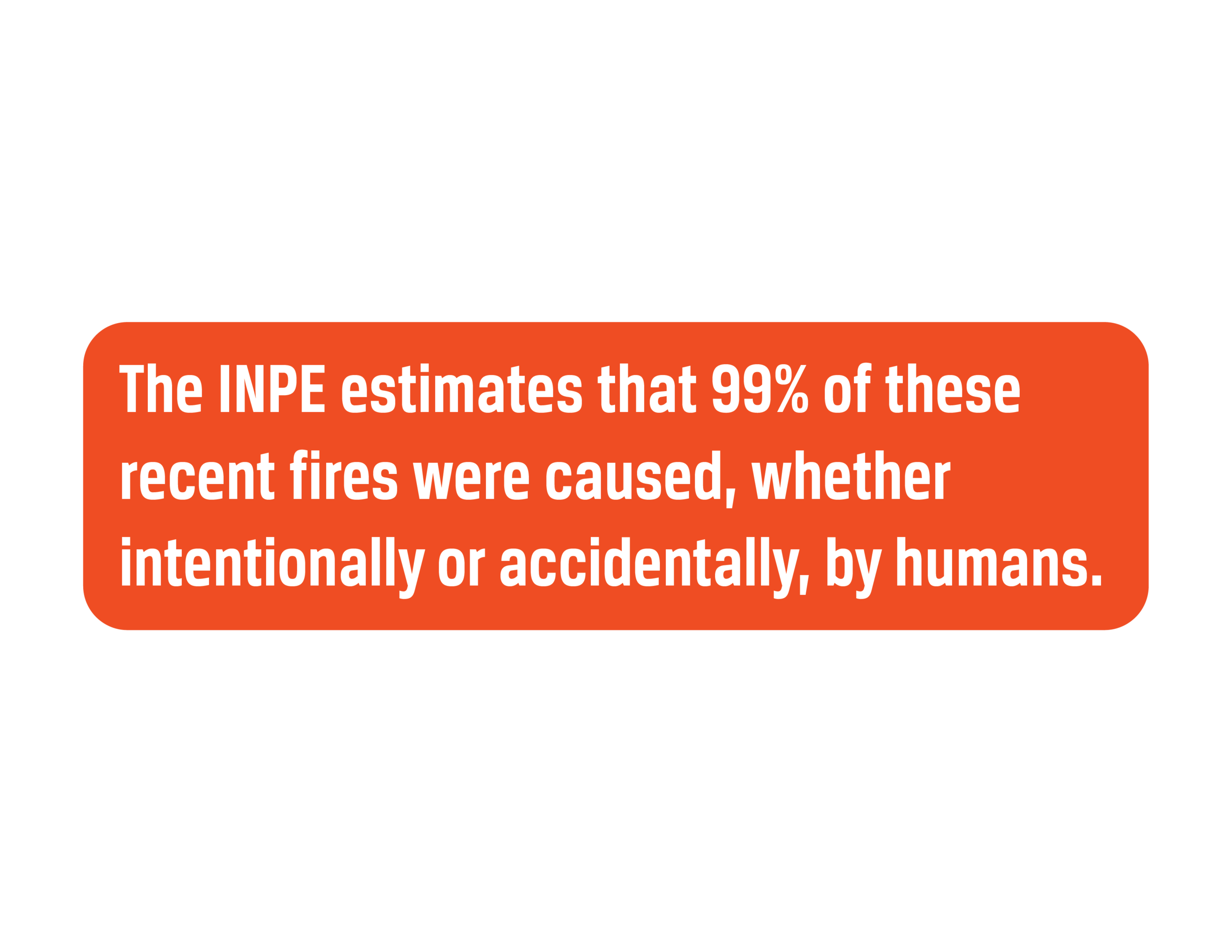
Increase in C02 Emissions
According to one study, 15% of global CO2 emissions are attributed to deforestation.77 However, the Amazon'southward role in the global direction of climate and CO2 levels is larger than that; deforestation in the Amazon leads not just to carbon emissions during the logging process, merely also from fires caused by deforestation. The massive tree loss brought about by deforestation has also led to a decreasing level of CO2 absorption in the Amazon.
Researchers say that the Amazon, which in one case used to be a massive carbon sink, may only be absorbing one-half as much carbon dioxide every bit it did 20 years ago, more often than not due to deforestation.78 Furthermore, 1 study in 2019 found that current prediction models for the Amazon's CO2 absorption, and their accompanying assumptions, did not take into consideration the depleted phosphorus levels in the Amazon's soil, which impacts a tree'due south ability to have in CO2.79 As a consequence, the study revealed that these predictions for absorption were inaccurate, every bit they were double the corporeality of absorption actually taking identify.80 In other words, this data is particularly relevant to global climate change equally the Amazon absorbs a quarter of the carbon dioxide captivated by all rainforests globally—a number which decreases with the rise of deforestation.81 Annually, the earth as a whole emits xl billion tons of CO2 into the air, 2 billion tons of which is absorbed past the Amazon rainforest.82
Deforestation'due south contribution to climatic change and carbon emission becomes cyclical when fire becomes involved. Slash-and-burn techniques use fire to clear forest, which emits additional CO2 into the atmosphere, along with the initial CO2 emissions that come with deforestation. Subsequently, stopping deforestation is widely recognized as 1 of the most effective fronts on which to battle climate modify, every bit the opposite effect on carbon emissions can be seen with reductions in deforestation.83
Water Cycle Changes
The meaning loss of vegetation from deforestation in the Amazon, and therefore transpiration of water that comes from that vegetation, negatively affects water cycles and triggers a bicycle of desertification and climate change not but in the region, just also around the earth.84 Locally, transpiration and evaporation accounts for 50-lx% of rainfall in the region of Amazonia, and shifts in such a big portion of the water cycle have consequences across the world.85
For example, in 2014, Princeton University-led researchers reported that widespread destruction of the Amazon rainforest could result in 20% less rain in the northwest The states, and 50% less snowpack in the Sierra Nevada. They likewise framed the implications of these effects, noting that the snowpack in the Sierra Nevada Mountains is an important source of h2o for irrigation in California'due south Cardinal Valley, and that California has been the The states' primary state for food and dairy production for the past 50 years.86
Another study showed that the effect of deforestation in the Amazon was stiff on water cycles effectually the world, reducing precipitation and cloudiness on multiple continents, mostly in the Americas, and of greatest note in the central United States.87 Some research indicates that these global water cycle shifts are so dramatic they could potentially crusade droughts in important agricultural areas in Bharat, Africa, Communist china, and the United States, where negative effects have already been traced back to Amazon deforestation.88 89 However, boosted changes in water cycles and subsequent desertification beyond a regional scale are only predicted to occur with much larger increases in Amazon deforestation.90
Practices
Monitoring Deforestation
Monitoring deforestation has been one of the first steps taken in many efforts to combat deforestation. By monitoring deforestation, authorities agencies hope to more easily enforce related laws and slow or eliminate deforestation. This practice includes abiding tracking, measuring, and mapping over time to determine the exact dimensions of the trouble. As an sensation grows of precisely where the deforestation happens, it becomes more possible to trace the deforestation back to specific causes and attack the problem at its roots. Many approaches accept been taken to monitor deforestation, including mostly cantankerous-sector collaborations. For case, the organization Imazon worked with Google to aid develop amend ways to track deforestation with their Google Earth Engine technologies, launching a platform called Sistema de Alerta de Desmatamento (Deplorable).91 92 These efforts culminated in the cosmos of Global Forest Watch—an online open-source platform that uses Landsat satellite imagery to monitor deforestation levels and trends in almost real-time. The Brazilian government's National Space Research Institute likewise monitors deforestation through a short-term system wood monitoring system called DETER.93 This system is the earth leader in using satellite data to monitor deforestation.94
On a more than basic level, and from a different angle, the Amazon Conservation Team (ACT) organization has equipped indigenous Amazonian persons with GPS engineering to better manage the wood that their lives depend on, and to better advocate with local governments, instead of relying on tertiary-party intervention.95 With GPS capabilities at their fingertips, ethnic people know the exact boundaries of the land they own—and therefore when their land rights are infringed upon—and monitor their lands with unprecedented precision and accuracy.96
Impact
Monitoring the deforestation of the Amazon closely allows root causes to be identified and specific action to be taken. Many groups take advantage of the monitoring tools and technologies that have recently been developed to farther the impact that they accept.97 For example, the Amazon Conservation Association (ACA), a non-profit NGO, reports that their usage of the Global Forest Picket allows them to "detect illegal golden mining and logging in protected areas inside days" and subsequently initiate government activeness inside 24-48 hours of receiving an alert.98 Many companies who intend to create more environmentally-conscious supply bondage are also able to utilize diverse tools available through Global Forest Lookout man to monitor suppliers and ensure that they know where and how the products are beingness sourced.99
Imazon attributes the 80% reduction of Amazonian deforestation betwixt 2004 and 2012 to the newly gained ability of monitoring deforestation with satellite imagery and disseminating that information widely on a regular basis.100
Gaps
Monitoring deforestation is a first step for many initiatives that tackle the issue, just simply monitoring a problem will never be a solution to that problem. Monitoring provides authentic data and nuanced information around the trouble of deforestation, merely the real value of monitoring comes when activeness is taken with the data. Many policy-makers accept resisted data around deforestation trends, underscoring the importance of more extensive solutions.101 Also, up until 2012, Brazil's DETER organisation received 250 metre-pixel MODIS (Moderate Resolution Imaging Spectroradiometer) information that illegal loggers leveraged to evade detection by only logging smaller areas, exploiting a potential weakness in many efforts to accurately monitor deforestation.102
Expanding Land Rights and Protections for Indigenous Peoples
Satellites take been useful in unveiling deforestation and pressuring local governments to bulldoze full levels of deforestation down, but another practice, starting on the ground instead of in the heaven, has proved efficient as well.103 This approach entails working with the indigenous people of the Amazon rainforest. Many approaches take been taken in this realm, simply all with the overarching goal of reducing deforestation via two principal strategies: expanding protected areas for indigenous people and educational activity indigenous people how to preserve their forest homes through the adoption of new technologies and practices (including effective lobbying with local governments).104
Impact
Working with ethnic people has proved to exist an impactful strategy for many decades when it comes to deforestation.105 Although not the most direct strategy, the data from several studies suggests a sizeable touch on: a report from the Earth Resource Institute showed that, in Brazil, deforestation in indigenous customs forests from 2000 to 2012 was less than 1%, compared with 7% outside them.106 Furthermore, the report showed that the higher amount of deforestation that had occurred outside ethnic community forests led to 27 times more carbon dioxide emissions than were produced from deforestation on indigenous community forests, and that indigenous community forests contain 36% more carbon per hectare than other areas of the Brazilian Amazon.107
In 1987, the unprecedented was achieved equally 20 million hectares of Amazon rainforest were given back to indigenous inhabitants.108 In 1990, Gaia Amazonas was founded and began to piece of work with indigenous people in expanding their protected territories and negotiating skills.109 In the Colombian Amazon, they have been able to create the largest continuous indigenous territory in the world, with 26 million hectares of Amazon woods legally recognized as ethnic territory.110 The organization'southward efforts have reached 26,000 indigenous people belonging to 100 communities in the Amazon by establishing a shared governance of protecting woods areas.111
Gaps
Working with indigenous people to aggrandize their rights for the purpose of reducing deforestation requires a deep agreement of their civilization, amongst other issues. Additionally, the impact of such activities is often difficult to measure, especially as the results of such activities may take some time to manifest. Although research indicates that at that place are more often than not lower deforestation rates in lands that are under ethnic stewardship as opposed to other Amazonian areas outside that category, how much correlation or causation exists is debatable and, based on historical data, it is difficult to predict how much expanding indigenous land rights would actually reduce deforestation in the future.112 Furthermore, although some inquiry has been done on how individual indigenous groups take been able to combat deforestation in combination with various conservation organizations, little has been washed in evaluating the impact that specific organizations accept on deforestation equally they work with indigenous people.113
Additionally, there have been multiple instances where indigenous tribes in the Amazon accept been granted legal rights over pieces of land, but and so turned around and sold those rights to logging companies, every bit the tribes wanted the coin more than than the land, and deforestation connected.114 Another struggle with expanding and granting ethnic land rights is enforcing those rights, which takes fourth dimension, money, and heavy authorities involvement, likewise as defining the responsibility of indigenous peoples for the sustainability or deforestation of their lands.115
Anti-Deforestation Legislation
Anti-deforestation legislation comes from diverse governing bodies and covers a wide spectrum of legislation including anti-logging, logging permit systems, protected area designations, sustainable forestry laws, sourcing laws, reforestation mandates and programs, cattle ranching mitigation, farming restrictions, and and so on. Equally the Amazon rainforest is the well-nigh prevalent expanse for deforestation in the world, it has captured a notable global involvement including gaining the attending of many lawmakers. Some examples of these types of legislation include the United Nation's REDD+ program (Collaborative Plan on Reducing Emissions from Deforestation and Forest Deposition in Developing Countries), Brazil's Forest Code,116 and diverse types of reforestation requirements, logging permits, agricultural credit systems, carbon credit systems, the Terra Legal programme, product embargoes, environmental licenses, the Public Forest Management law, and then on.117
Impact
The largest impact from anti-deforestation legislation the Amazon has seen has been from laws that designate territory for indigenous people. As previously stated, ethnic customs forests have been shown to emit 27 times less carbon dioxide from deforestation than neighboring non-indigenous administered lands.118 The government has strongly enforced logging laws and jailed many perpetrators, only isolating a reduction of deforestation from specific laws is more difficult and not well documented.119
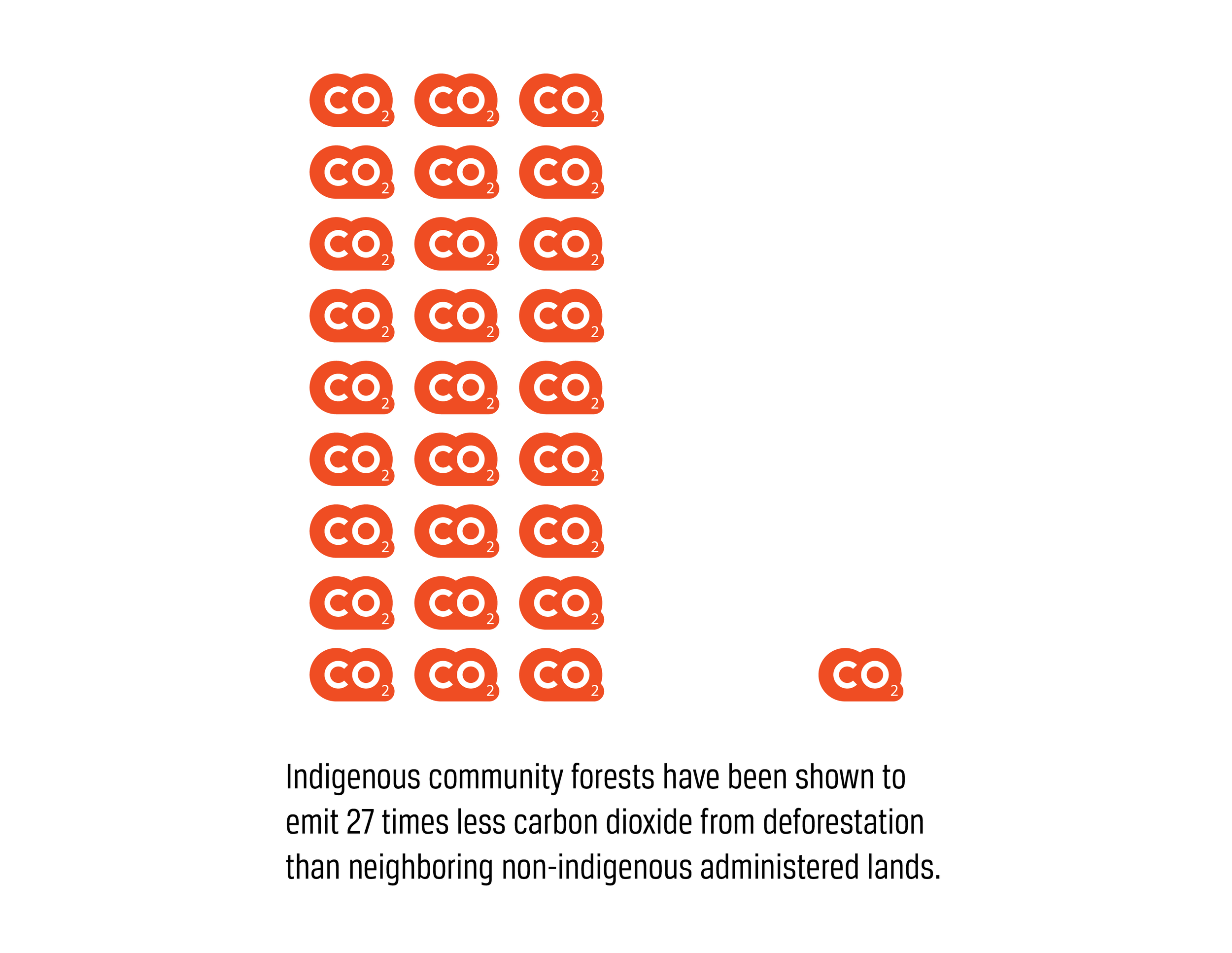
Gaps
The legislative procedure has notoriously lagged far behind the devastating consequences of deforestation, and as soon as laws are created and enforced, many times there are nonetheless loopholes that are taken reward of. Not every constabulary has been airtight. Creating laws and enforcing them are 2 carve up things; many times the two do not come together every bit laws are created but left inadequately enforced, making them effectively nonexistent.
As mentioned previously, areas designated as protected are routinely defective the personnel and resources to adequately be protected.120 For instance, a recent study showed that the authorities of Brazil has weakened when it comes to creating and enforcing legal systems, which has triggered an increase in laundering soy, cattle, and timber, too equally mostly subverting legislation through allow fraud.121 122
Protected Area Designations
Reforming land policy is another angle from which many accept tackled deforestation, including designating areas equally protected and expanding protections. Protected areas can take the form of preserved areas for indigenous people, national parks, and fifty-fifty include the surface area called the Legal Amazon or Amazonia Legal (Legal Amazon) in Brazil.123 Other protective designations include Amazon Regional Protected Areas (ARPA),124 which is another Brazilian designation, also every bit "sustainable apply reserves,"125 biological reserves,126 legal reserves, and Areas of Permanent Protection.
Touch
Three recent studies highlight the impact of land policy reform. The first study, washed by the World Resources Institute, showed indigenous community forests emitting 27 times less carbon dioxide from deforestation than neighboring non-indigenous administered forests.127 Some other written report showed that protected areas of the Amazon avoided or displaced 34,000–39,000 km2 of deforestation.128 Additionally, a 2013 written report out of the University of Michigan showed that indigenous lands perform the best when information technology comes to lowering deforestation, although all forms of protection practise limit deforestation to some degree.129
Gaps
Flaws tin can certainly be nowadays in protecting land, equally theory ofttimes differs from reality when resource are lacking to execute protections. As of 2011, half of protected areas in the Brazilian Amazon had no approved management plan and 45% had no management council.130 Staffing in some protected areas is very depression—the state of Pará has only one officer per ane,817 square kilometers of wood.131
Some designations are more effective than others. For instance, sustainable use reserves are oft abused and therefore not every bit effective in preventing deforestation as other designations.132 Furthermore, designating an area as protected does not necessarily reduce deforestation in and of itself, peculiarly if adequate resources are non deployed in actually protecting information technology, and protective laws are not enforced against those who violate them. Unfortunately, in much of the Amazon, even protected areas go casualty to deforestation at times.133
Source: https://ballardbrief.byu.edu/our-briefs/deforestation-in-the-amazon-rainforest
Posted by: rogersocke2001.blogspot.com

0 Response to "How Deforestation Affects Animals In The Amazon"
Post a Comment